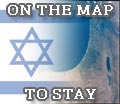
Elisson gets up close and personal with the Western Wall. (Photograph ©2012 Gary Feinberg Photography, used by permission.)
There’s an old joke in which a member of an American tour group in Jerusalem sees an elderly man praying by himself in the far northern corner of the Western Wall plaza - the Kotel Ha-Ma’aravi. Curious, the American waits for the man to finish praying before walking up to ask a few questions.
“How often do you come here to pray?”
The elderly fellow responds, “Oh, I come here every day. Three times a day, morning, afternoon, and evening, a Jew is supposed to pray. And thanks be to HaShem, I’ve been able to daven here at the Kotel ever since the Six Day War in 1967.”
“Three times a day? Every day since June of 1967?”
“Yes, that’s right.”
“May I ask what it is you pray for?”
“Well, I say the prayers like I was taught when I was a little boy... the Sh’ma, the Shemoneh Esrei, Aleinu Leshabeakh. I also pray for the health of my family and friends - the few that are left, that is - and the safety and security of the State of Israel. I also pray that there should be peace in the world, between us and our Muslim and Christian brothers, peace for all mankind.”
“Why, that’s wonderful!” says the tourist. “And how is all that working out for you?”
The old guy shrugs his shoulders. “To tell you the truth, it’s like talking to a wall!”
It took me nearly sixty years, but last month I finally got to see that selfsame Wall, the one towards which, for nearly two millennia, Jews worldwide have turned their faces while praying.
[I should point out that the Kotel Ha-Ma’aravi, despite the apparent veneration directed towards it, is not itself in any way sacred. Jews may pray at the Wall; they never pray to the Wall. And the Wall is not, as news outlets are so fond of saying, “the most sacred site in Judaism.” That title is reserved for the Temple Mount, which sits above and to the east of the Wall. But Jews are forbidden to pray there, as the spot where the Temple once stood is occupied by the Dome of the Rock, a Muslim holy site constructed in 689-691 C.E. The Kotel, a portion of the western retaining wall of the Mount, is as close as we can get.]
Interactive panorama of the Kotel Plaza.
We got our first glimpse of the Kotel Plaza on Friday evening, having arrived in time to see the crowds streaming in prior to sunset and the onset of Shabbat. It had been a quick cab ride from our hotel to the Jaffa Gate, then through the Armenian and Jewish quarters. As we passed through stone archways and through narrow, walled streets, pedestrians of all descriptions walked alongside us. Many of them were decked out in full ultra-orthodox regalia, wearing traditional long coats (kapote) and with streimels - cylindrical fur hats - atop their heads. You’ve gotta be seriously religious to wear a fur hat in Jerusalem in the summer.
The plaza was jam-packed, with more people arriving every minute. As we approached the Wall, She Who Must Be Obeyed, along with the other women in our group, peeled off towards the Women’s Section, worship at the Kotel being sexually segregated. That left us men to continue onward, pressing our way into the gathering crowds.
I had planned to go all the way to the Wall itself, but our little group stopped about halfway, distracted by hordes of young men - Yeshiva bochers - singing and dancing. Parking myself at one of the many tables set up to accommodate worshipers, I observed the singing and dancing with one eye whilst listening to a black-hatted gentleman next to me as he davened Minchah, the afternoon service, with characteristic fervor.
There was a small pile of prayerbooks on the table, so I picked one up with the intention of saying my own Minchah prayers... and the book opened, seemingly of its own volition, to Shalom Aleikhem, a beloved Friday night hymn.
Shalom aleikhem, mal’akhei ha-shareit
Mal’akhei elyon
Mimelekh mal’khei ham’lakhim
Ha-Kadosh Barukh Hu...
Peace be unto you, ministering angels,
Messengers of the Most High,
The King of Kings,
The Holy One, blessèd be He.
One of the first Hebrew melodies I learned as a youngster was Shalom Aleikhem, and as I stood there with the rosy light of the setting sun reflected upon the ancient stones of the Kotel, I remembered singing that very same hymn to my grandfather - Eli’s father - some fifty years ago. Tears welled up in my eyes. Could Grandpa Jack ever have imagined that one day I would stand in this place and think of him?
There would be another visit to the Kotel during our trip, a visit during which I would read Torah while standing at Robinson’s Arch, would touch those ancient stones with my own hands, and would follow the wall along its entire length, walking in the cool shade of the tunnels. I would stop at a little alcove, as close to the actual location of the old temple’s Sanctum Sanctorum as it is physically possible to go, and cram a few kvittlach - scraps of paper inscribed with prayers - into the crevices between the stones.
But that was to be later. This was Friday evening - erev Shabbat - and amidst the joyous thousands, it was just me, the Wall, and my grandfather of blessèd memory.




















2 comments:
While I do not share your Faith, being of Christian bent, this story left me with goosebumps.
It must have been a joyous trip.
Nicely put. Thanks for sharing. If I never have the chance to visit myself, I will at least be able to say someone I know has been, and touched the stones with their hands.
Post a Comment